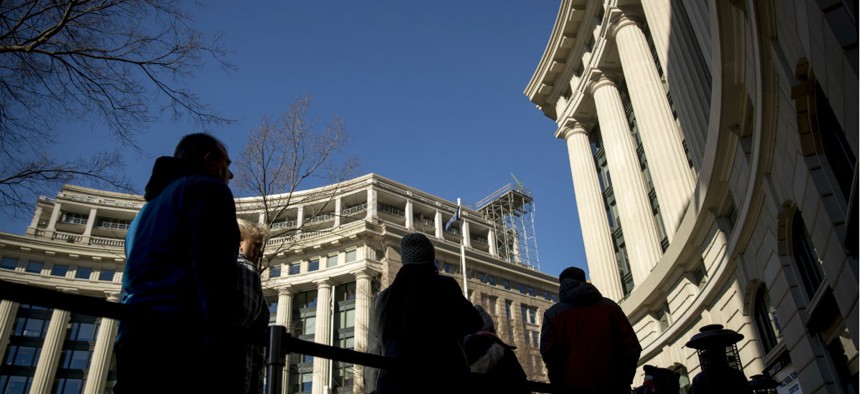Study: Federal Workforce Is on the Verge of Catastrophe
Without a significant overhaul, agencies may fail to provide adequate services when they are needed most, researchers found.
A new study released by the Senior Executives Association paints a dire picture of the federal workforce, one that is stretched too thin, hampered by old technology and the target of partisan attacks. Without a significant overhaul, agencies may fail to provide adequate services when they are needed most, the researchers found.
The report, released last week, seeks to answer the question in its title: “Are Declines in U.S. Federal Workforce Capabilities Putting our Government at Risk of Failing?” The conclusion of the authors, longtime government observers and practitioners, is not reassuring: "Has the U.S. federal government reached a point where critical operations might fail in stressful events that are likely to occur? This was this project’s animating question. Based on the data collected in this study, it appears the answer to these critical questions is yes."
The study notes that the federal government has longstanding staffing problems in relation to increased responsibilities and a rise in overall government spending.
“The U.S. executive branch has hardly grown in 60 years—there were 1.8 million civilian employees in 1960, and 2.1 million in 2017,” the study states. “Yet over the same period the amount of money spent by the federal government has grown fivefold. To be sure, contracts and grants have filled part of the gap, but, still, both the amount and range of work required of the federal workforce has continued to go up, just as the scope and complexity of executive branch functions also increased.”
Compounding the challenge, several key departments have seen a brain drain from their upper echelons since President Trump’s inauguration in 2017, well above the turnover seen in previous presidential transitions.
“Between 2016 and 2017, the Department of State lost 10 percent of GS-15 staff and 13 percent of SES; the Department of Education lost 12 percent of its GS-15 staff and 7 percent of SES; for Department of Labor 6 percent and 7 percent, for Department of Defense 7 percent and 9 percent, and for the Department of Agriculture 3 percent and 12 percent,” the report found. “Another specific indicator of the turmoil was the number of GS-15s who left government not through retirement. More than twice as many cabinet-level GS-15s quit in 2017 as in 2009, a comparable point for the previous administration.”
As a result, the authors reported a trend of “increasing work overload” among federal employees, who often lack either the time or money to perform their regular duties adequately. An inadequate system for rewarding high performance, coupled with “plenty of penalties” if actions don’t pan out, have led to a workforce that is “fatally risk averse and as a result chooses inaction to action during critical times.”
Perhaps most alarming has been the expansion of the number of political appointees at federal agencies over the last half century and the deepening suspicion they seem to have of career civil servants. The study's authors found a growing desire by appointees to drive out career senior executives out of fear over their perceived personal political views, a dynamic that has ground decision-making on how to steer the federal workforce to a halt:
“Since the 1980s, executive branch leadership has been increasingly dictated by legislation and executive orders, both of which have served to politicize executive branch leadership and diminish the traditional managerial role played by career executives . . . The appointees are bound to be suspicious of the civil servants because, after all, they had worked for the ‘other guys’ if the presidency had changed party . . . In earlier years, though, the suspicion usually didn’t last long: political appointees first realized that they couldn’t get anything done without the civil servants, and not long after that, realized that as a general and principled rule, civil servants regarded themselves as working for the country, not any party. That seems to have changed, even dramatically. Our interlocutors spoke of dissent channels being leaked, resulting in what they regarded as 'witch hunts' . . . Each change in administration is like a hostile corporate take-over. In the process the civil service becomes demoralized and paralyzed.”
To reverse course and ensure agencies can provide services to the public during potential future crises, the study recommends establishing “safe spaces” for career federal employees to focus on the non-partisan work of government, adoption of new technologies, and mitigation of vulnerabilities.
“The rapidly changing world requires new ways of organizing who does what work in public service and how to include bottom-up, more ‘entrepreneurial-on-the-inside’ activities not typically associated with how public service has functioned in the past,” the report said.
The study also recommends a “comprehensive census for federal staffing” be done on a regular basis as part of an ongoing and systemic evaluation of government operations that need a stimulus of talent. And it argues that the private sector must take a more active role in promoting best practices, rather than simply “pursuing profits.”
“If the U.S. private sector were willing to take a leadership role to help improve both local communities and the United States as a whole, in addition to pursuing profits, this too could improve the resilience of the country to future crises—after all, united we stand, divided we fall,” the authors stated.








